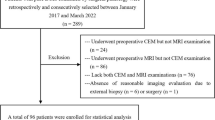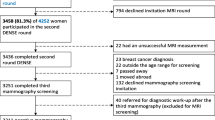Abstract
The purpose of this study was to compare contrast-enhanced spectral mammography (CESM) with mammography (MG) and combined CESM + MG in terms of detection and size estimation of histologically proven breast cancers in order to assess the potential to reduce radiation exposure. A total of 118 patients underwent MG and CESM and had final histological results. CESM was performed as a bilateral examination starting 2 min after injection of iodinated contrast medium. Three independent blinded radiologists read the CESM, MG, and CESM + MG images with an interval of at least 4 weeks to avoid case memorization. Sensitivity and size measurement correlation and differences were calculated, average glandular dose (AGD) levels were compared, and breast densities were reported. Fisher’s exact and Wilcoxon tests were performed. A total of 107 imaging pairs were available for analysis. Densities were ACR1: 2, ACR2: 45, ACR3: 42, and ACR4: 18. Mean AGD was 1.89 mGy for CESM alone, 1.78 mGy for MG, and 3.67 mGy for the combination. In very dense breasts, AGD of CESM was significantly lower than MG. Sensitivity across readers was 77.9 % for MG alone, 94.7 % for CESM, and 95 % for CESM + MG. Average tumor size measurement error compared to postsurgical pathology was −0.6 mm for MG, +0.6 mm for CESM, and +4.5 mm for CESM + MG (p < 0.001 for CESM + MG vs. both modalities). CESM alone has the same sensitivity and better size assessment as CESM + MG and was significantly better than MG with only 6.2 % increase in AGD. The combination of CESM + MG led to systematic size overestimation. When a CESM examination is planned, additional MG can be avoided, with the possibility of saving up to 61 % of radiation dose, especially in patients with dense breasts.




Similar content being viewed by others
References
Kolb TM, Lichy J, Newhouse JH (2002) Comparison of the performance of screening mammography, physical examination, and breast US and evaluation of factors that influence them: an analysis of 27,825 patient evaluations. Radiology 225(1):165–175
Pisano ED, Gatsonis C, Hendrick E, Yaffe M, Baum JK, Acharyya S, Conant EF, Fajardo LL, Bassett L, D’Orsi C, Jong R, Rebner M, Digital Mammographic Imaging Screening Trial Investigators G (2005) Diagnostic performance of digital versus film mammography for breast-cancer screening. N Engl J Med 353(17):1773–1783. doi:10.1056/NEJMoa052911
Tabar L, Vitak B, Chen TH, Yen AM, Cohen A, Tot T, Chiu SY, Chen SL, Fann JC, Rosell J, Fohlin H, Smith RA, Duffy SW (2011) Swedish two-county trial: impact of mammographic screening on breast cancer mortality during 3 decades. Radiology 260(3):658–663. doi:10.1148/radiol.11110469
Smith-Bindman R, Miglioretti DL, Johnson E, Lee C, Feigelson HS, Flynn M, Greenlee RT, Kruger RL, Hornbrook MC, Roblin D, Solberg LI, Vanneman N, Weinmann S, Williams AE (2012) Use of diagnostic imaging studies and associated radiation exposure for patients enrolled in large integrated health care systems, 1996–2010. J Am Med Assoc 307(22):2400–2409. doi:10.1001/jama.2012.5960
Cooney CM (2010) Cancer report examines environmental hazards. Environ Health Perspect 118(8):a336. doi:10.1289/ehp.118-a336a
Institute of Medicine of the National Academes (2011) Breast cancer and the environment: a life course approach. Rep Br December:1–4
Schmidt CW (2012) IOM issues report on breast cancer and the environment. Environ Health Perspect 120(2):a60–a61. doi:10.1289/ehp.120-a60a
Agency IAE (2002) International action plan for the radiological protection of patients. Gov/2002/36-GC(46)/12:1–9
Eastman TR (2013) ALARA and digital imaging systems. Radiol Technol 84(3):297–298
European Society of R (2011) White paper on radiation protection by the European Society of Radiology. Insights Imaging 2(4):357–362. doi:10.1007/s13244-011-0108-1
Potter-Lang S, Dunkelmeyer M, Uffmann M (2012) Dose reduction and adequate image quality in digital radiography: a contradiction? Der Radiol 52(10):898–904. doi:10.1007/s00117-012-2337-9
Shaw P, Crouail P (2013) ALARA in existing exposure situations: 14th European ALARA network workshop, 4–6 September 2012, Dublin. J Radiol Prot Off J Soc Radiol Prot 33(2):487–490. doi:10.1088/0952-4746/33/2/M02
Dromain C, Thibault F, Diekmann F, Fallenberg EM, Jong RA, Koomen M, Hendrick RE, Tardivon A, Toledano A (2012) Dual-energy contrast-enhanced digital mammography: initial clinical results of a multireader, multicase study. Breast Cancer Res 14(3):R94. doi:10.1186/bcr3210
Dromain C, Thibault F, Muller S, Rimareix F, Delaloge S, Tardivon A, Balleyguier C (2011) Dual-energy contrast-enhanced digital mammography: initial clinical results. Eur Radiol 21(3):565–574. doi:10.1007/s00330-010-1944-y
Fallenberg EM, Dromain C, Diekmann F, Engelken F, Krohn M, Singh JM, Ingold-Heppner B, Winzer KJ, Bick U, Renz DM (2014) Contrast-enhanced spectral mammography versus MRI: initial results in the detection of breast cancer and assessment of tumour size. Eur Radiol 24(1):256–264. doi:10.1007/s00330-013-3007-7
Puong S, Bouchevreau X, Patoureaux F, Iordache R, Muller S (2007) Dual-energy contrast enhanced digital mammography using a new approach for breast tissue cancelling. Proc SPIE Med Imaging 6510:65102H. doi:10.1117/12.710133
Braun M, Polcher M, Schrading S, Zivanovic O, Kowalski T, Flucke U, Leutner C, Park-Simon TW, Rudlowski C, Kuhn W, Kuhl CK (2008) Influence of preoperative MRI on the surgical management of patients with operable breast cancer. Breast Cancer Res Treat 111(1):179–187. doi:10.1007/s10549-007-9767-5
Schaefer FK, Eden I, Schaefer PJ, Peter D, Jonat W, Heller M, Schreer I (2007) Factors associated with one step surgery in case of non-palpable breast cancer. Eur J Radiol 64(3):426–431. doi:10.1016/j.ejrad.2007.02.033
Diekmann F, Diekmann S, Jeunehomme F, Muller S, Hamm B, Bick U (2005) Digital mammography using iodine-based contrast media: initial clinical experience with dynamic contrast medium enhancement. Invest Radiol 40(7):397–404
Dromain C, Balleyguier C, Muller S, Mathieu MC, Rochard F, Opolon P, Sigal R (2006) Evaluation of tumor angiogenesis of breast carcinoma using contrast-enhanced digital mammography. AJR Am J Roentgenol 187(5):W528–W537. doi:10.2214/AJR.05.1944
Jong RA, Yaffe MJ, Skarpathiotakis M, Shumak RS, Danjoux NM, Gunesekara A, Plewes DB (2003) Contrast-enhanced digital mammography: initial clinical experience. Radiology 228(3):842–850. doi:10.1148/radiol.2283020961
Lewin JM, Isaacs PK, Vance V, Larke FJ (2003) Dual-energy contrast-enhanced digital subtraction mammography: feasibility. Radiology 229(1):261–268. doi:10.1148/radiol.2291021276
Berg WA, Gutierrez L, NessAiver MS, Carter WB, Bhargavan M, Lewis RS, Ioffe OB (2004) Diagnostic accuracy of mammography, clinical examination, US, and MR imaging in preoperative assessment of breast cancer. Radiology 233(3):830–849. doi:10.1148/radiol.2333031484
Bosch AM, Kessels AG, Beets GL, Rupa JD, Koster D, van Engelshoven JM, von Meyenfeldt MF (2003) Preoperative estimation of the pathological breast tumour size by physical examination, mammography and ultrasound: a prospective study on 105 invasive tumours. Eur J Radiol 48(3):285–292
Fasching PA, Heusinger K, Loehberg CR, Wenkel E, Lux MP, Schrauder M, Koscheck T, Bautz W, Schulz-Wendtland R, Beckmann MW, Bani MR (2006) Influence of mammographic density on the diagnostic accuracy of tumor size assessment and association with breast cancer tumor characteristics. Eur J Radiol 60(3):398–404. doi:10.1016/j.ejrad.2006.08.002
Esserman L, Cowley H, Eberle C, Kirkpatrick A, Chang S, Berbaum K, Gale A (2002) Improving the accuracy of mammography: volume and outcome relationships. J Natl Cancer Inst 94(5):369–375
Lobbes MB, Lalji U, Houwers J, Nijssen EC, Nelemans PJ, van Roozendaal L, Smidt ML, Heuts E, Wildberger JE (2014) Contrast-enhanced spectral mammography in patients referred from the breast cancer screening programme. Eur Radiol. doi:10.1007/s00330-014-3154-5
Dance DR, Skinner CL, Young KC, Beckett JR, Kotre CJ (2000) Additional factors for the estimation of mean glandular breast dose using the UK mammography dosimetry protocol. Phys Med Biol 45(11):3225–3240
Acknowledgments
We are grateful to Michaela Krohn, MD, Jasmin-Maya Singh, MD, Nikola Bangemann, MD, Angela Reles, MD, and Christiane Richter-Ehrenstein, MD, and for their contribution in the patient recruitment and inclusion. We are thankful to Prof. Marc Dewey for discussions about this paper and to Bettina Herwig for editorial support.
Conflict of interest
E.M.F. Financial activities related to the present article: GE Healthcare provided some funding to pay for the actual research per patient, but authors were completely in control of the patients and data. E.M.F. received payment for lecture or advisory board participation from GE, Bayer and Siemens and funding from Siemens, Bayer and GE. B.H. received payment for consultancy for Toshiba and is stock holder of all medical companies. F.D. received payment for lecture or advisory board participation from GE and Phillips and funding from GE, Bayer and Mevis. C.D. received funding from GE. U.B. received remuneration for License agreements and Royalties from Hologic and funding from Siemens, Hologic and Toshiba. D.M.R, A.U.N., K-J.W., B.I., and F.E. had no conflicts of interest.
Author information
Authors and Affiliations
Corresponding author
Rights and permissions
About this article
Cite this article
Fallenberg, E.M., Dromain, C., Diekmann, F. et al. Contrast-enhanced spectral mammography: Does mammography provide additional clinical benefits or can some radiation exposure be avoided?. Breast Cancer Res Treat 146, 371–381 (2014). https://doi.org/10.1007/s10549-014-3023-6
Received:
Accepted:
Published:
Issue Date:
DOI: https://doi.org/10.1007/s10549-014-3023-6




